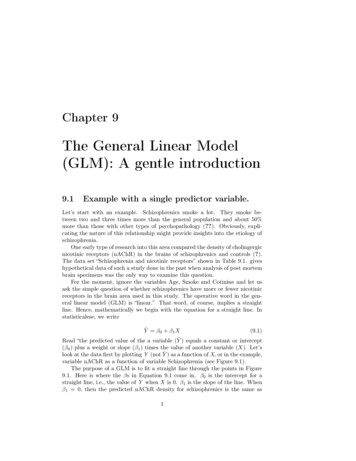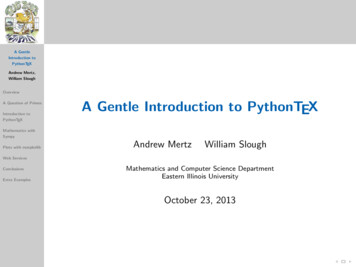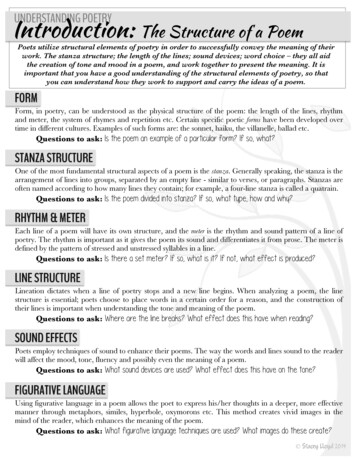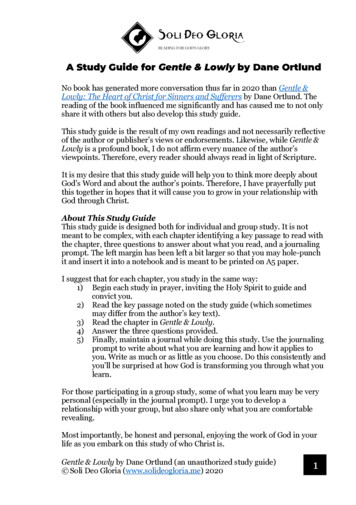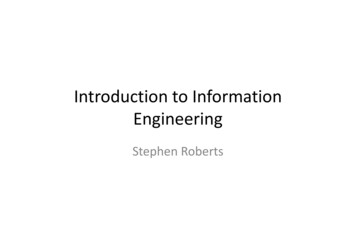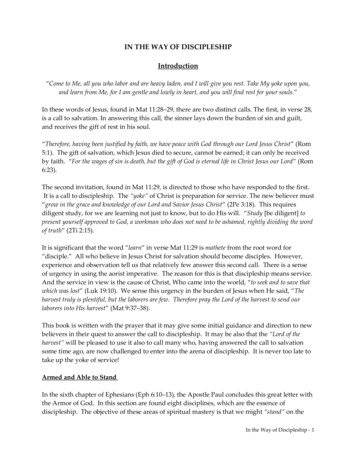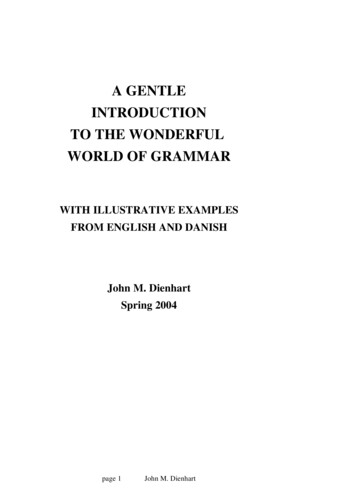
Transcription
A GENTLEINTRODUCTIONTO THE WONDERFULWORLD OF GRAMMARWITH ILLUSTRATIVE EXAMPLESFROM ENGLISH AND DANISHJohn M. DienhartSpring 2004page 1John M. Dienhart
University of Southern DenmarkInstitute of Language and Communicationpage 2John M. Dienhart
TABLE OF CONTENTSpageSection 1: Preliminaries51.1. Introducing the course51.1.1.About this . The advantage of a single uniform system ownadvantages61.1.1.4. The need for reform in language teachingthroughout the Danish education system61.1.1.5. Fear of grammar1.1.1.6.6In-textreferences61.2. About the author1.2.1. The author’s current affiliations with variouslevels of the Danish education system1.2.1.1. Working with the University of SouthernDenmark(SDU)61.2.1.2. Working with the traditional Danishsecondary schools (stx, hf)61.2.1.3 Working with HHX and HTX1.2.1.4.Working with teacher training collegesand primary schools6page 3John M. Dienhart6
1.3. Course design and goals71.4. The intended audience71.5. A Danish version71.6. Why study grammar?81.7. Knowing grammar vs. knowing about grammar8Section 3: A CASE STUDY: tagquestions in English and Danish 8Section 4: About VISL4,1. Background114. 2. Some basic principles (P0 – P8)114.2.1, Segmentation and classification (P0)114.2.2. Four basic types of constituent (P1)114.2.3. Two labels – form and function (P2)124.2.4. VISL’s “cafeteria” of word classes with fixed color scheme(P3)124.2.4.1. The blue/green spectrum (fornoun-related word classes)124.2.4.2. The red/orange spectrum(for verb-related word classes)134.2.4.3. Other colors134.2.5. The syntactic structure of groups (P4)144.2.6. The syntactic structure of paratagms (P5)154.2.7. The syntactic structure of clauses (P6)154.2.8, Dealing with discontinuous constituents (P7)154.2.9. One system for all VISL languages (P8)164. 3. Syntactic trees164.3.1. About nodes164.3.2. About branches164.3.3. About leaves164.3.4. Relationships among constituents164.3.5. Ill-formed trees16page 4John M. Dienhart
Exercise 5a: Some short sentences for syntactic analysis234.4. Games and quizzes244.4.1. Match Form4.4.2. Paintbox244.4.3. Word Fall244.4.4. Shooting Gallery244.4.5. Labyrinth244.4.6. Match Function4.4.7. Syntris244.4.8. Space Rescue254.4.9. Balloon Ride262626Section 5: Learning about forms5.1. One-word constituents: Learning about word classes5.1.1.“Minor” , “major” and “other” word classes5.1.1.1 “Other” word classes5.1.1.1.The numeral5.1.1.2 The infinitive marker5.1.1.3. The interjection5.1.1,2. The “major” word classespage 5John M. Dienhart2824
5.1.1.2.1. The noun5.1.1.2.2 The verb5.1.1.2.3 The adjective5.1.1.2.4 The adverb5.1.1.3. The “minor” word classes245.1.1.1.1. The article5.1.1.1.2. The preposition5.1.1.1.3. The conjunction5.1.1.1.4. The pronoun5.1.1.1.1. Independent personal pronouns5.1.1.1.2. Dependent personal pronounsExercise 5a: Working with archaic pronouns355.1.1.1.3. Demonstrative pronouns5.1.1.1.4. Relative pronouns5.1.1.1.5. Interrogative pronouns5.1.1.1.6. Reflexive pronouns5.1.1.1.7. Indefinite pronouns5.1.1.4.The “major” word classespage 6John M. Dienhart24
5.1.1.4.1. The noun5.1.1.4.2. The verb5.1.1.4.3. The adjective5.1.1.4.4. The adverb5.2. Multi-word constituents: groups, paratagms and clauses5.2.1. Groups5.2,2. Paratagms5.2.3. ClausesSection 6: Learning about functionsSection 7: Learning about constituent analysis:combining form and function8. Glossary of grammatical terms used in the book9. Symbol list (forms and functions)10. The VISL color scheme for word classes11. Direct links to VISL’s language games and quizzes12. Referencespage 7John M. Dienhart
page 8John M. Dienhart
SECTION 1: Preliminaries1.1. Introducing the course1.1.1. About this bookThough I draw on material from both English and Danish, the book is not tobe viewed as an English grammar nor as a Danish grammar. Instead it aims atupgrading the reader’s grammatical literacy by focussing on basicterminology and by investigating some of the current issues in grammar andgeneral linguistics – using concrete data from English and Danish. Why thesetwo languages? English, because it is the author’s native language and because Englishgrammar has been his primary area of teaching and research for morethan three decades.Danish, because the primary readership is intended to be teachers andstudents affiliated with all levels of the Danish educational system.Ideally, readers should profit by improving their understanding of grammar ingeneral, while at the same time adding to their knowledge of (corners of)English and Danish grammar. Furthermore, by making use of data from twolanguages, the book provides a comparative and contrastive element whichyields an additional perspective on both linguistic data and theory.Hopefully, readers will begin to notice some benefits from the book whenthey peruse one or more of the standard grammar books for Danish or anyforeign language – simply as a result of becoming more familiar withgrammatical terminology and grammatical analysis. I hope, too, that studentsat all levels will be able to sense that teacher presentations and classroomdiscussions become more meaningful. This will have a cumulative effect ontheir learning curve, as understanding in given areas promotes understandingin new areas.1.1.1.1. Integration with the VISL websiteI should stress that this book is but a pale reflection of its electroniccounterpart – a highly interactive web-book freely accessible on the Internet atthe following address:visl.sdu.dkpage 9John M. Dienhart
By integrating the book with the VISL website (VISL Visual InteractiveSyntax Learning; see Section 2 for a fuller description of the VISL website),the book becomes more than a “book” – it becomes a full-fledged electronic“course”, incorporating from the start a number of useful and excitingfeatures, including the following: You gain access to a highly advanced and sophisticated IT-system,ensuring a maximum of interactive participation.You can move through the course at your own pace and tailor yourprogress to your own strengths and weaknesses.You receive immediate feedback on your performance.The course incorporates a high degree of “edutainment” ( education entertainment). You have at your fingertips a number of languagegames and quizzes – by means of which you can test yourknowledge of grammar as it increases throughout the course.You have the chance to compete worldwide for high scores in manyof the games.There is constant variation in the course materials. A fundamentalprinciple of the VISL system is that monotonous repetition should beavoided. Generally speaking, this means that each time you select aparticular language game or quiz, the task will be different. Thus it isknowledge rather than a good memory that is the key factor behind asuccessful performance.You have access to a wide choice of languages. The VISL sitecurrently provides materials for 21 different languages – Arabic,Bosnian, Danish, Dutch, English, Esperanto, Finnish, French,German, Greek (both ancient and modern), Italian, Japanese, Latin,Latvian, Norwegian (both bokmål and nynorsk), Portuguese,Russian, Spanish, and Swedish.1.1.1.2 The advantage of a single uniform system of symbols and terminologyWhile all these features offer clear advantages to the course participant, themost significant advantage of tapping into VISL, in my view, is the following:page 10John M. Dienhart
Grammar is simplified by being codified in one uniform system. VISL usesthe same system of analysis, the same terminology, and selects from the sameset of symbols for all 21 languages currently available at the website. Thismeans that once you have mastered the system for e.g. English, you are readyto apply it to any of the other VISL languages. The one exception is Arabic,whose grammatical tradition is radically different from that of the other VISLlanguages.1.1.1.3. A printed book has its own advantagesWhile I strongly recommend using the electronic version of this text, sincethat will maximize the interactive aspect of the course, it cannot be denied thatthe more traditional book form also has a number of advantages: its use isindependent of energy sources and modern technology, you can read it in bed,in the garden, or at the beach (without fear of getting sand in the keyboard),you can give it to friends on special occasions, you can use a highlighter tomark up particular passages, you can add marginal notes, you can ask theauthor to autograph your copy, etc.1.1.1.4. The need for reform in language teaching throughout the Danisheducation systemIn an unusually forthright and outspoken article entitled ”Fra sprogfag tilsprogkompetence – nødvendige perspektiver for det danskeuddannelsessystem” ( ”From language discipline to language competence”),Niels Iversen, Associate Professor ( “lektor”) at the Institute for CurriculumResearch, the Danish University of Education ( “Danmarks PaedagogiskeUniversitet”) severely criticizes the way language teaching is currentlycarried out in the Danish school system.It is rare that an author expresses his opinion so openly and so clearly. Hereare a few excerpts that seem most directly relevant to reforming the existinglanguage program.* * * * *The teacher training programs are no longer in tune with the levels of teachingthey are supposed to serve; they are not professional enough. This is due to thefact that Denmark has no clear language policy, – with the result that thecountry suffers from a lack of connection and cohesion among the variouslevels. (p. 1)* * * * *page 11John M. Dienhart
It is striking how modest the difference is between the formulated goals for thegrade school diploma on the one hand and for a university degree on theoyher. (p. 1)* * * * *The teacher training programs (which also involve the university) no longermeet the demands of the education system. (p. 2)* * * * *It seems to be a tradition in Denmark that the staff who teach language coursesview language acquisition as an irritating hindrance. Language teaching can bedescribed in terms of the traditional adventure paradigm: a long journey withobstacles and monsters that prevent the young hero from reaching the treasure/maiden. The language aspect is undervalued despite – or perhaps just because– it is the main issue! Language disciplines are treated increasingly asdisciplines where various topics are discussed, whereas the focus should be onovercoming specific difficulties in the development of the discursive skillsneeded for such discourse. In language disciplines expression is the content.(p. 3)* * * * *The symbiosis between secondary education and the university hasevaporated. The current institutional profiles arise from a form of society longgone. It is odd to witness how little the Danish education system has kept upwith developments in the rest of society. The situation is serious for languagedisciplines – not least the linguistic competence which requires such a longtime to develop. (p. 3)* * * * *When budget pressures arise within the language disciplines, it is generally thelanguage courses which suffer. They are easy targets, undervalued as they areby most university teachers. These courses are typically not well integrated inbasic research, which in itself is a serious mistake. This is due, among otherthings, to the fact that the current staff has very little practical experience fromthe secondary schools. They are recruited within a closed circuit. Theireducation is becoming poorer and poorer. Having served as an externalexaminer at university level for many years, I can conclude that manygraduates simply have not reached a linguistic level that corresponds to thelevel of competence which quite reasonably is required. Everybody knowsthat this is true, but nobody will say it publicly. This development offers a realthreat to foreign language competence. It is not simply a question of funding.(p. 4)* * * * *I am continually amazed that the linguistic competence of future teachers ispage 12John M. Dienhart
still based on an education program which is becoming notoriously poorer andpoorer. . . Future language teachers should ideally be educated linguistically ina region where the target language is spoken by native speakers. Research hasshown that this is the optimal context. It is absurd that the linguistic training ofyoung Danes is based on Danish teachers who are not linguisticallycompetent. Unfortunately this generalisation holds throughout the educationsystem. There are far too many badly trained language teachers. And thesituation is getting worse with the advent of information technology. (p. 4)* * * * *My own experience as a university teacher of English confirms much of whatNiels Iversen is saying. I would like to add an additional variable, however:“fear”.1.1.1.5. Fear of grammarI have been teaching courses in English grammar and general linguistics atuniversity level since coming to Denmark in 1971, and – unfortunately – Ibelieve the following claim is justified: most of my new students each yearfeel that no one could seriously associate the word wonderful with the wordgrammar (as I have done in the book title). But I am serious, and I hope thatthis web-course will help justify my claim.On the positive side, I have experienced that there is usually a small minorityof new students who need no convincing at the outset, and I like to believethat by the end of my university course, a few of the other students have comearound to my view.An interesting question to raise at this point is this: Where does this fear ofgrammar come from? The answer can only be that like the taste for snaps,licorice, coffee, or peanut butter, it has been acquired – acquired during theeducation process itself. The fear represents a kind of negative education. Partof the problem, I believe, is that students are exposed to such a variety ofterminology, sy
English and Danish grammar. Furthermore, by making use of data from two languages, the book provides a comparative and contrastive element which yields an additional perspective on both linguistic data and theory. Hopefully, readers will begin to notice some benefits from the book when they peruse one or more of the standard grammar books for Danish or any foreign language – simply as a .

